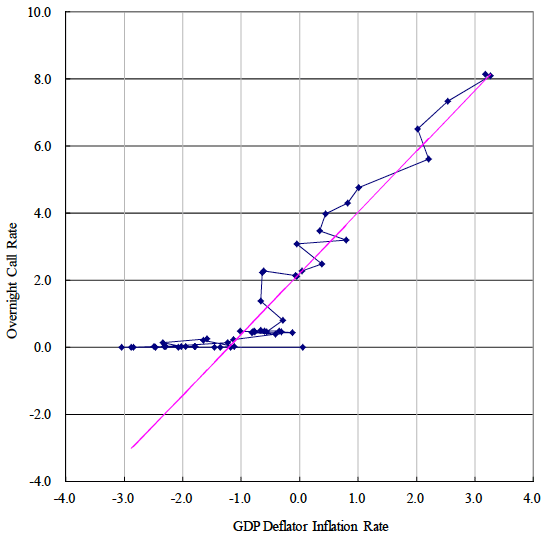| Author Name | FUKAO Mitsuhiro (Faculty Fellow, RIETI) |
|---|---|
| Research Project | Policy Mix for Fiscal Consolidation Without Harming Japan's Economic Recovery |
| Download / Links |
This Non Technical Summary does not constitute part of the above-captioned Discussion Paper but has been prepared for the purpose of providing a bold outline of the paper, based on findings from the analysis for the paper and focusing primarily on their implications for policy. For details of the analysis, read the captioned Discussion Paper. Views expressed in this Non Technical Summary are solely those of the individual author(s), and do not necessarily represent the views of the Research Institute of Economy, Trade and Industry (RIETI).
Social Security, Taxation, and Public Finance (FY2011-FY2015)
Policy Mix for Fiscal Consolidation Without Harming Japan's Economic Recoveryation
Japan's inflation rate, measured in terms of the implicit price deflator for the gross domestic product (GDP), fell from 3% in the early 1990s to nearly zero percent in 1994 and has been in negative territory since at between minus 1% and minus 3%. In response, the Bank of Japan (BOJ) has been seeking to stimulate economic recovery by driving down short-term money market rates. However, after the benchmark overnight call rate was brought down to 0.5% in 1995, compared to 8% in the early 1990s, the BOJ has been left with practically no room to lower the overnight call rate further. In the figure, the horizontal axis represents the GDP deflator inflation rate and the vertical axis indicates the overnight call rate, illustrating their changes over time. It shows that the BOJ was able to lower the overnight call rate to zero percent until the inflation rate reached negative 1%, but it was no longer able to do so thereafter, blocked by the zero bound constraint.
Figure: Inflation Rate and Short-term Money Market Rate (1991 Q1-2004 Q1)

Note: The red regression line is estimated using data prior to 1999 Q1 when theBOJ faced a zero-lower bound.
The government implemented a range of fiscal measures to pump-prime the economy but failed to generate the intended effects due partly to the financial crisis from 1997 through 2002. In the meantime, government debt continued to grow. Under this circumstance, the BOJ launched its quantitative easing policy in 2001. But this was not enough to eliminate deflation, either.
In the spring of 2013, the government of Prime Minister Shinzo Abe appointed Haruhiko Kuroda as the new governor of the central bank. Under the leadership of Kuroda, the BOJ embarked on an unprecedented quantitative easing by increasing the purchase of government bonds to a level far exceeding the previous level under the conventional quantitative easing. This new policy led to a substantial depreciation in the yen and higher stock prices, thereby prompting economic recovery. However, even though the decline in the GDP deflator has been brought nearly to a halt under the new quantitative easing regime, it has not yet reached the point of turning upward, and the market prediction is that the BOJ's goal of achieving 2% inflation rate by early 2015 will be unattainable. Meanwhile, the government is trying to reduce fiscal deficits by raising the consumption tax rate in two steps by five percentage points in total, as determined under the government of Prime Minister Yoshihiko Noda. However, the simulation results presented in the discussion paper show that the decrease in fiscal deficits to be achieved through such two-stage tax hike is far from enough, and it is expected that government debt will grow rapidly in the coming years unless additional drastic measures--i.e., a fairly large-scale tax hike and a significant cut in fiscal spending--are implemented.
Budget tightening and sustainable growth are indispensable to achieving the two goals of economic recovery and fiscal consolidation. This will require implementing a new set of macroeconomic and structural reform policies in a bold and decisive manner. The discussion paper proposes a scheme in which the government would levy a tax of 1% to 2% on the outstanding amount of government-guaranteed financial assets by announcing the policy well beforehand as a way to achieve negative interest rates. More specifically, it is calling for introducing negative interest rates in the form of taxation on yen bank deposits as well as on central and local government bonds so as to stimulate consumption and investments. The taxation of bank deposits would prompt a flight to cash. In order to prevent this, the central bank could issue a new set of banknotes and charge fees for exchanging old banknotes with new ones, or the government might as well abolish physical cash by replacing it entirely with electronic money such as PASMO and Suica which can be easily taxed. This is meant to be an economic stimulus scheme by means of a present day version of the stamp duty proposed by Silvio Gesell. Meanwhile, as a way to maintain the growth potential, the paper calls for a shift in the government's immigration policy to allow foreign nationals with sufficient Japanese language proficiency to work in Japan. It suggests that the government might as well issue 50,000 to 70,000 working visas per year to accept such foreign nationals as workforce and alleviate the impact of the declining population in Japan.

